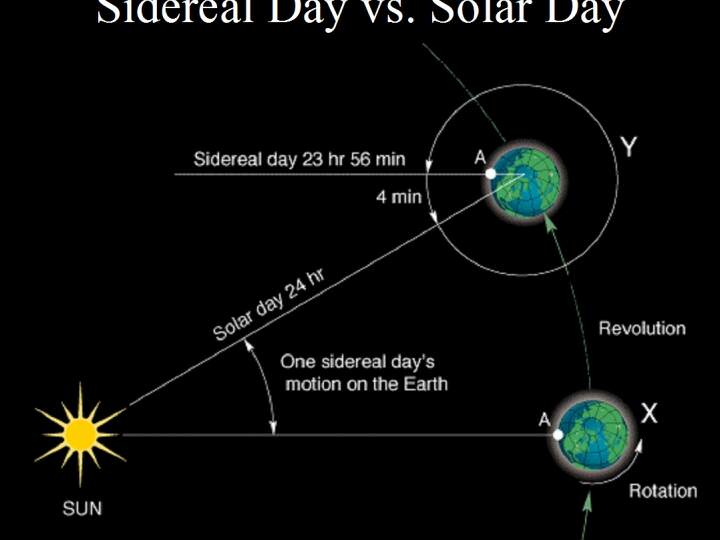

Time has always held significance throughout the course of human history. In the field of astronomy, time takes on a particularly fascinating role. It represents the duration of events and provides a framework for evaluating life itself. Without the concept of time, it would be challenging to define and understand the world around us.
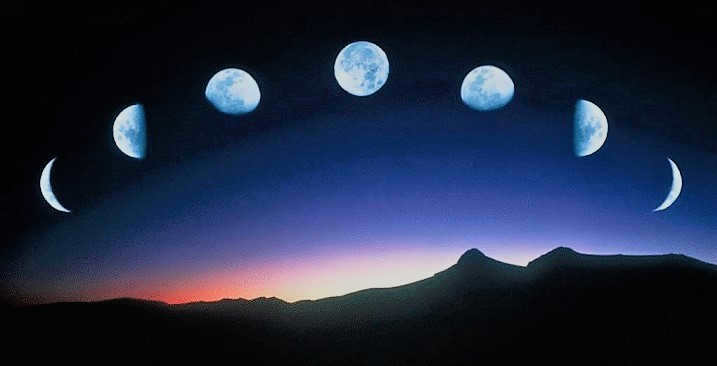
Julian days
Astronomers have adopted a unique system for numbering days, which follows a 28-year cycle. Within this cycle, all days and weeks repeat themselves.
This method of measuring time was developed by John Herschel in 1849. The counting of time began at noon on April 1st, 4713 BC. Its usage was proposed by Joseph Scaliger, who named it Julian in honor of Julius’ father.
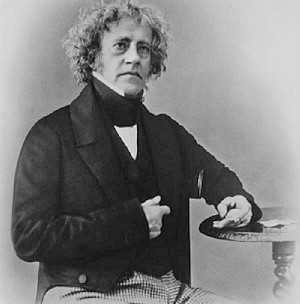
“The universe and time are boundless. Therefore, every occurrence is inevitable, even the inconceivable.”
from the film Route 60.
Stellar time in the field of astronomy.
A sidereal day corresponds to the interval between two successive crests.
This measurement in the field of astronomy can be defined as the hour angle of the vernal equinox point. Furthermore, sidereal time is measured starting from this point.
A sidereal day refers to the time it takes for the Earth to complete one full rotation on its axis. They are divided into hours, minutes, and seconds. One year consists of one additional stellar day compared to the average solar year.
As one can observe, the sidereal day is shorter than the average solar day. The established difference is 3 minutes and 56 seconds.
Astronomy and the Concept of Solar Time
In the field of astronomy, the application of sidereal time proves to be quite convenient. However, it is not applicable to everyday human life. As a result, the concept of solar time was introduced.
Solar time is determined by the changes in the hour angle of the Sun. This method of time calculation relies on the interval between two consecutive culminations of the Sun, with the distinction of whether these culminations are upper or lower. This differentiation allows for the determination of either noon or midnight.
True and average solar time in astronomy
Solar time can be classified as either true or average, depending on the reference point used to determine it.
True solar time is based on the Earth’s revolution around the Sun. It is measured from the period of the Sun’s lower culmination, which is considered to be true midnight.
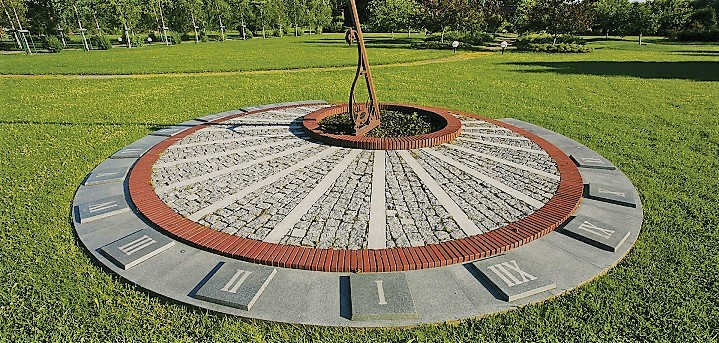
The movement of the Sun is not constant. Consequently, the duration of a solar day on December 22 is slightly longer than on September 23, by almost one minute. However, this slight variation poses difficulties when it comes to accurate calculations.
In our daily lives, we consider a day to be 24 hours in duration. Time is typically measured in seconds. Additionally, we divide the day into morning, afternoon, evening, and night, which depends largely on the position of the Sun relative to a specific meridian.
Nevertheless, the average solar day is used for precise timekeeping.
It represents the time interval between two successive culminations of the mean equatorial Sun on the same meridian. It would be more accurate to say that the mean solar day corresponds to the average length of the true solar day.
The Sun’s movement along the ecliptic is characterized by its average speed. This movement reaches its closest convergence on January 3 and July 4.
The equatorial path of the Sun follows a similar uniform pattern, but it aligns with the ecliptic Sun specifically at the vernal equinox. The average position of the equatorial Sun remains constant and consistent in relation to true solar time.
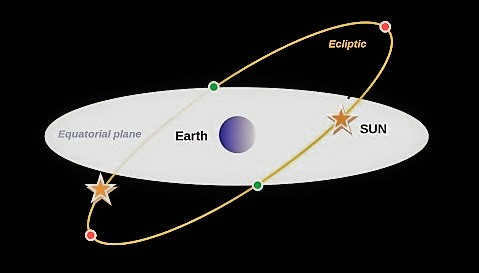
Time zones
Primarily used in geography, time zones refer to the divisions of the Earth based on meridians. There are a total of 24 meridians, each separated by 15 degrees of longitude.
It is conventionally agreed that the main meridian, known as the world meridian, is the initial meridian with zero longitude.
Meridians run from west to east, and neighboring zones have a one-hour time difference. To determine the time in a specific zone, one must know the zone number.
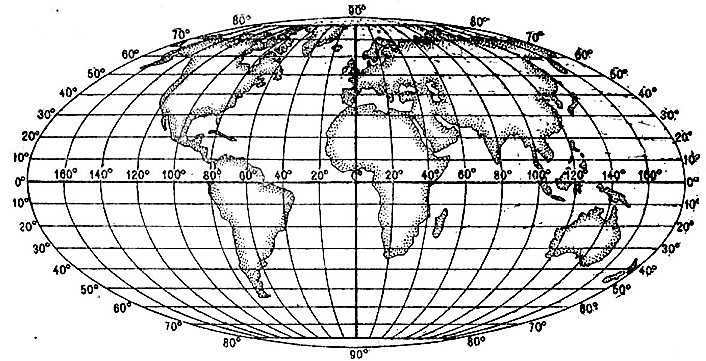
Essentially, universal time refers to the time in a particular time zone. It is widely accepted that a day is composed of 24 hours and commences at midnight.
International time
As an illustration, Russia encompasses 9 distinct time zones. In 1930, the concept of standard time was established. An additional hour was introduced to the time zone.
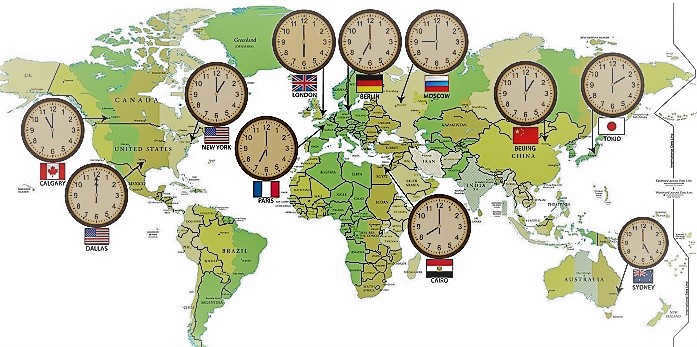
Moscow time is another term for universal time in astronomy.
This definition of time implies the application of the time of the adjacent zone. In simpler terms, Moscow time is equal to the local time plus one hour.
According to the latest concepts, it is referred to as local time.
Ephemeris time
This is a time standard that defines seconds. The measurement of such time is not influenced by the Earth’s rotation speed.
Furthermore, it serves as the fundamental unit of time. This concept was introduced by J. M. Clemens in 1952.
Ephemeris time is constant and is utilized, in essence, for ease of calculation.
“Subtract an hour of time from a person, subtract a person’s life-a difference in magnitude.”
Frank Herbert
As evident, time represents the duration of something. We must recognize it as the most distinct duration and value that humans have delineated. Additionally, numerous methods have been devised for its calculation.

Without a doubt, time holds great significance for individuals. It serves as a fundamental aspect of their existence.
As the clock ticks, it will unveil the mysteries of the future.
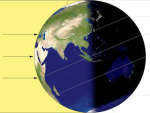
Understanding the rotation of the Earth and the duration of a day
6.02.2008 22:35 K. V. Kuimov/GAISH, Moscow
Astronomy enthusiasts are well aware of the various interpretations of the term “day.” These include the stellar day and the solar day. However, in recent times, numerous new concepts have emerged that utilize the same word. This article aims to provide more precise definitions for these concepts.
1. A day as a unit of time
Firstly, let’s remember that in astronomy, just like in other scientific disciplines, the unit of time is the second of the SI international system of units – the atomic second. The 13th General Conference of Weights and Measures in 1967 provided the following definition of a second:
| A second is the duration of 9,192,631,770 periods of radiation of the caesium 133 atom emitted by it during the transition between the two superfine levels of the ground state (for more information, refer to the International Bureau of Weights and Measures page). |
If we use the term “day” to refer to a unit of time, it should be understood as 86400 atomic seconds. Astronomy also utilizes larger units of time: the Julian year consists of exactly 365.25 days, while the Julian century consists of exactly 36525 days. In 1976, the International Astronomical Union, a public organization of astronomers, recommended that astronomers adopt these units of time. The primary time scale, Time Atomic International (TAI), is based on readings from various atomic clocks in different countries. Consequently, from a formal perspective, astronomy is no longer the foundation of time measurement. The outdated units of “average solar second” and “stellar second” should be avoided.
Defining the utilization of the term “day” can be somewhat challenging. There exist various factors contributing to this complexity.
Firstly, the Earth’s rotation axis, or its angular velocity vector, does not maintain a constant direction in space. This phenomenon is known as precession and nutation. Secondly, the Earth itself does not maintain a constant orientation relative to the vector of its angular velocity. This is known as pole motion. As a result, the radius-vector (the segment from the Earth’s center to a point on the surface) of an observer on the Earth’s surface will not return to its previous direction after one revolution (and never at all). Thirdly, the Earth’s rotational velocity, or the magnitude of the angular velocity vector, also does not remain constant. Therefore, strictly speaking, there is no definite period of the Earth’s rotation. However, with a certain degree of accuracy, within a few milliseconds, we can discuss the rotation period of the Earth around its axis.
Furthermore, it is essential to specify the orientation with respect to which we will calculate the Earth’s rotations. Currently, astronomy employs three such orientations. These include the orientation towards the vernal equinox, the Sun, and the celestial ephemeris.
The duration of the Earth’s rotation with respect to the vernal equinox is referred to as sidereal days. It amounts to 23 h 56 m 04.0905308 s. It is worth noting that a sidereal day is a period relative to the vernal point, rather than the stars.
Finally, let’s consider the Earth’s rotation in relation to the Sun. This scenario is the most complex, as the Sun’s movement in the sky does not follow the equator, but rather the ecliptic, and even then, it is not uniform. However, these solar days hold great significance for humanity. In the past, the atomic second was adjusted to match the Earth’s rotation period with respect to the Sun, with an average calculated for the 19th century. This period amounted to 86400 time units, known as average solar seconds. The adjustment occurred in two stages: first, “ephemeris time” and “ephemeris second” were introduced, and then the atomic second was aligned with the ephemeris second. As a result, the atomic second is still “derived from the Sun,” but atomic clocks are a million times more precise than their “terrestrial” counterparts.
The duration of the Earth’s rotation is not constant. There are numerous factors that contribute to this phenomenon. These include changes in temperature and air pressure distribution across the globe, internal processes, and external influences. The variations in rotation can be categorized into secular deceleration, irregularities occurring within decades, seasonal changes, and sudden shifts. Graphs 1 and 2 illustrate the fluctuation in day length between 1700 and 2000, as well as between 2000 and 2006. Graph 1 demonstrates a tendency towards longer days, while Graph 2 highlights the non-uniformity in day length throughout the seasons. These graphs are based on data from the International Earth Rotation and Reference Systems Service (IERS, http://www.iers.org/).
Is it possible to return the basis of time measurement to astronomy and is it worth considering? There is a potential opportunity in using pulsars, which have highly accurate rotation periods, for this purpose. Additionally, there are numerous known pulsars. It is conceivable that over long time intervals, such as decades, observations of pulsars could help refine atomic time and establish a “pulsar time” scale.
The study of irregularities in the Earth’s rotation is crucial for practical purposes and fascinating from a scientific standpoint. For instance, satellite navigation relies on knowledge of the Earth’s rotation. Furthermore, studying its variations provides insights into the Earth’s internal structure. This complex issue awaits further investigation.
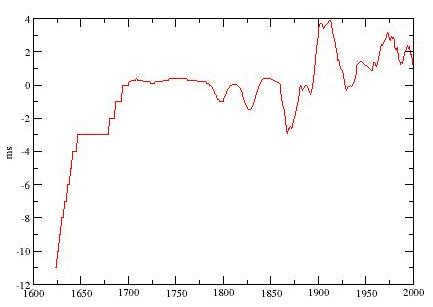
Figure 1. The Earth’s rotation period deviates from the standard 86400 s SI by a few milliseconds. The accuracy of the data before the 20th century is questionable, but there is a clear trend of increasing day duration.
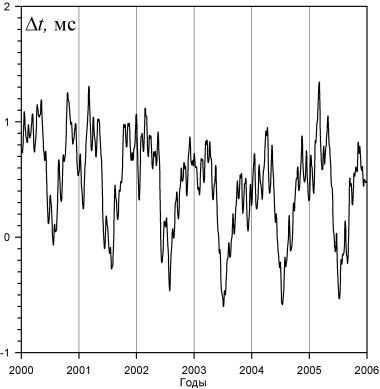
Figure 2. Variation in the length of the day between 2000 and 2006. The graph illustrates the deviation of the Earth’s rotation period from 86400 s (SI seconds), in milliseconds. The presence of seasonal fluctuations is easily discernible.
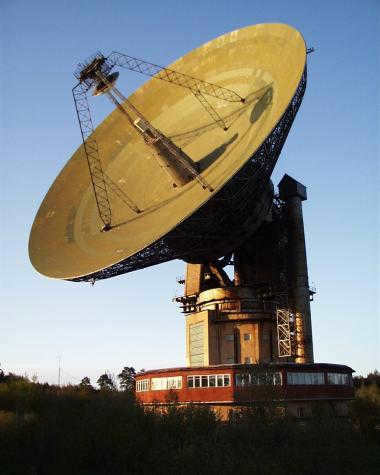
Figure 3. A radio telescope located near Kalyazin is utilized for the investigation of the Earth’s rotation.
Literature
- Zharov V.E. Spherical Astronomy. (A copy of this publication can be obtained from Astronet).
- Proceedings of the Institute of Applied Astronomy of the Russian Academy of Sciences, vol. 10, 2004.
- Sidorenkov N.S. Physics of Earth rotation instabilities. M., Fizmatlit. 2002.
- Kovalevsky J., Seidelman P.K.. Fundamentals of astrometry. Cambridge University Press, 2004.
- Oduan K., Guinot B. Time Measurement, Fundamentals of GPS. M., Technosphere, 2002.

At present, there are 58,741 educational establishments that qualify for extra cumulative savings (ranging from 2% to 25%). To determine the applicable discount for all staff members at your educational institution, please sign in to your personal Infoworks account.


Enroll in our professional retraining course
Learn how to manage electronic services for archives, libraries, and information-library centers.
We offer the opportunity to combine your educational institution’s discount with our own discount. The amount of your discount will depend on how many of your colleagues have already taken Infoworks courses.
Currently, we provide additional discounts (ranging from 2% to 25%) to 58,741 educational institutions. To find out what discount is available for all employees of your educational institution, please log in to your personal Infoworks account.


Professional retraining course
Organization of librarian activity in professional education
In addition to this discount, you can also take advantage of the discount offered by your educational institution (the amount of the discount depends on how many of your colleagues have already completed Infoworks courses).
Currently, 58,741 educational institutions are eligible for additional discounts ranging from 2% to 25%. To find out which discount applies to all employees of your educational institution, please log in to your personal Infoworks account.
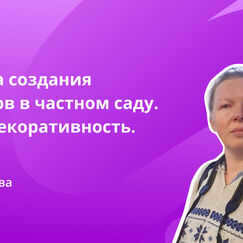

Experience designing flower beds in a personal backyard. Enhancing the summer aesthetic
Summary of the presentation through separate slides:

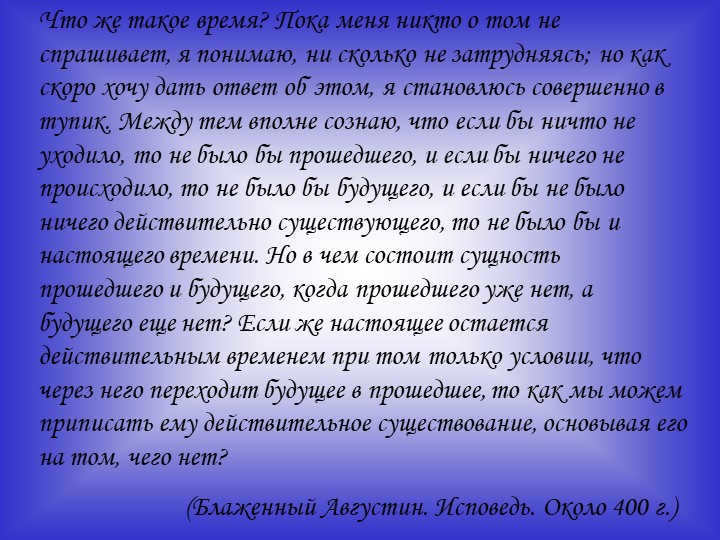
Slide 3: The concept of time is something that I can easily grasp until someone asks me to explain it. Then, I find myself at a loss for words. I understand that without things passing away, there would be no past, and without things happening, there would be no future. Additionally, if nothing truly existed, there would be no present time. However, I am left questioning the essence of the past and future. The past no longer exists, and the future has not yet come into being. How can we attribute a valid existence to the present when it is based on what does not exist? (Blessed Augustine. Confessions. ca. 400).
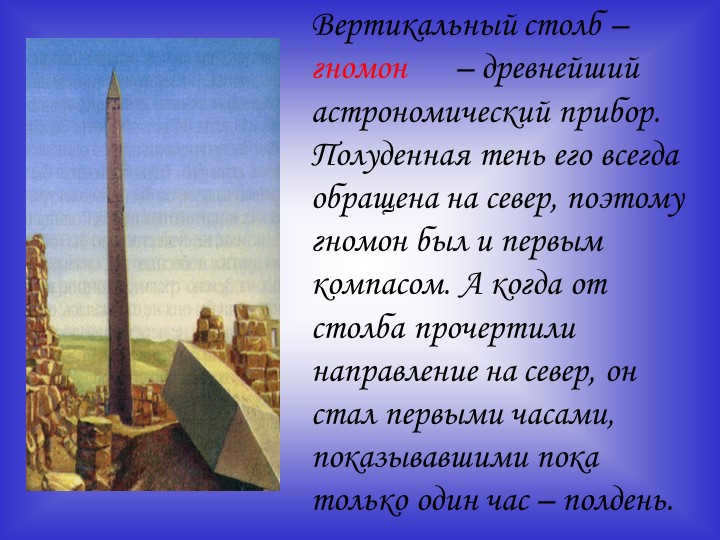
4 Slide The vertical pole, known as the gnomon, serves as the oldest astronomical device. It has the unique ability to always cast a shadow that points towards the north during midday. This characteristic also made the gnomon the first compass. Moreover, by drawing a line from the pole to the north, it became the very first clock that indicated only one specific hour – noon.
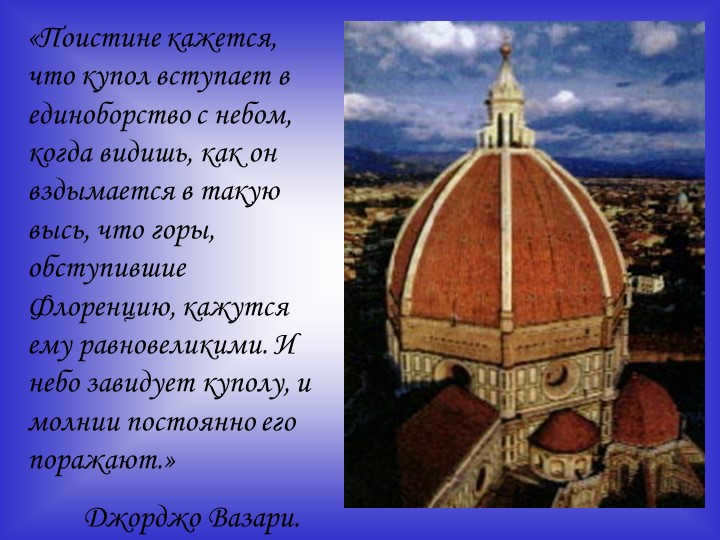
Indeed, it appears that the dome engages in a solitary battle with the heavens, as it ascends to such tremendous heights that the mountains encircling Florence appear to be on par with it. Furthermore, the sky harbors envy towards the dome, and bolts of lightning consistently strike it.
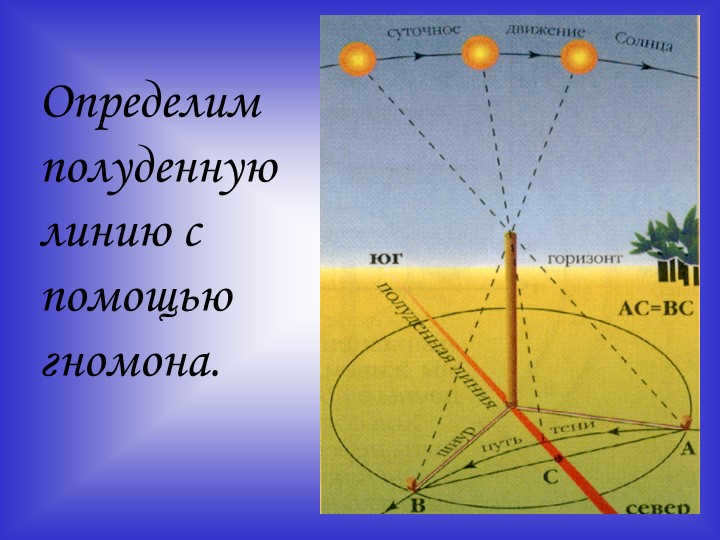
An Earth day refers to the period it takes for the Earth to complete one full revolution in space.
A solar day, on the other hand, represents the time it takes for the planet to revolve around the center of the Sun.
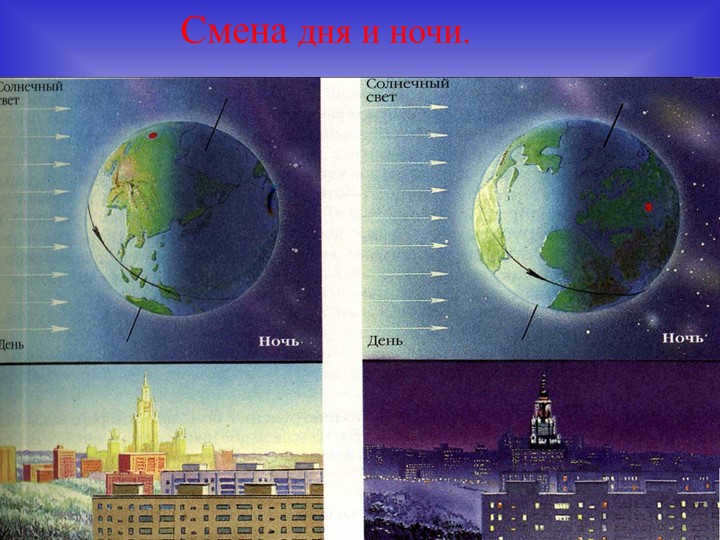
Slide 9 showcases the Delhi Observatory, home to the largest sundial in the world. A sundial is a remarkable instrument that helps us measure time by using the position of the sun’s shadow. It allows us to divide the day into smaller intervals and make these divisions visible. The Delhi Observatory, established in 1834 by Johann Littrow, is a testament to humanity’s fascination with the mysteries of the sky.
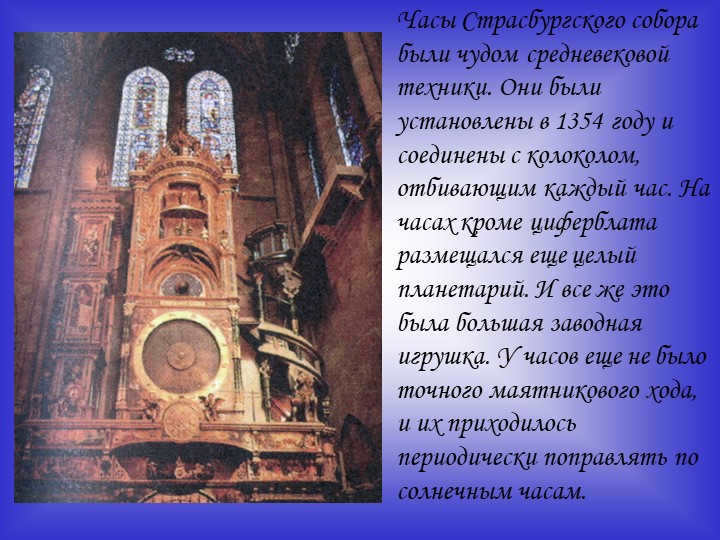
The clock in the Strasbourg Cathedral, which was installed in 1354, was a remarkable feat of medieval engineering. It featured a bell that would chime every hour and also housed a complete planetarium alongside the dial. However, despite its impressive features, the clock was essentially a large wind-up toy. It did not have a precise pendulum stroke and had to be regularly adjusted using a sundial.
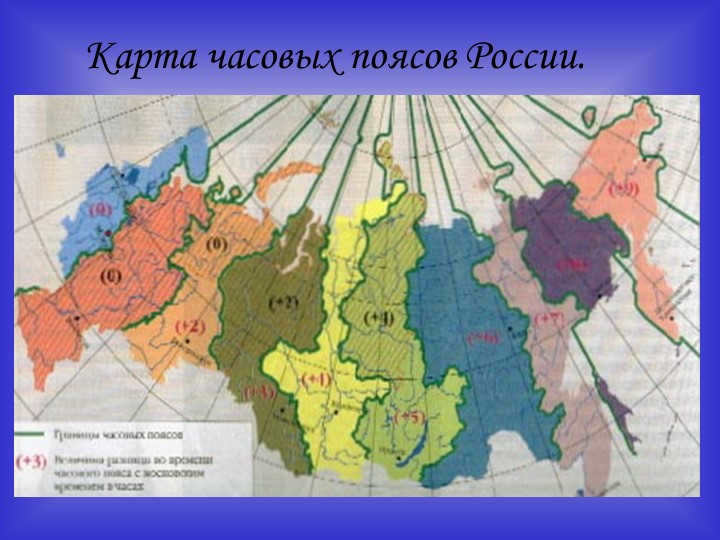
12 slide How to calculate local time.
Universal Time (UT) is the standard time for the entire Earth. For each specific location in Russia with a longitude of λ, we can determine the local true solar time Ti, the local mean solar time MT, the zone time Tn, the seasonal winter time Th, the seasonal summer time Tl, and the local sidereal time S.
MT = Ti + η, Th = UT + n + 1h,
MT = UT + λ, Tl = UT + n + 2h,
Tp = UT + n, S = s + MT (approximately),
– where η represents the equation of time; n is the time zone number; s is the sidereal time at Greenwich midnight (a table of sidereal times can be found in astronomical calendars).
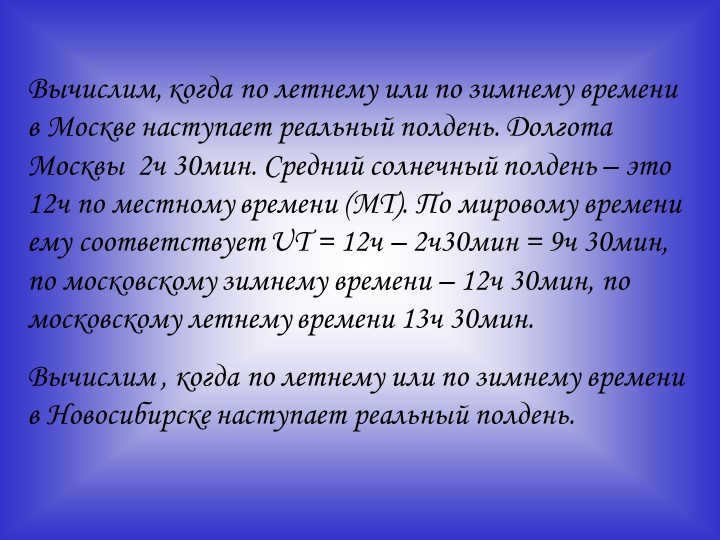

Slide 13 Let’s determine the exact time of noon in Moscow based on whether it is summer or winter. Moscow is located at a longitude of 2h 30min. The average solar noon occurs at 12h local time (MT). This corresponds to UT = 12h – 2h30min = 9h 30min on a global scale, 12h 30min in Moscow during winter time, and 13h 30min in Moscow during summer time.
Let’s calculate when the real noon comes in Novosibirsk based on whether it is summer or winter time.

At present, there are 58,741 educational establishments that qualify for additional cumulative discounts (ranging from 2% to 25%). To determine the applicable discount for all staff members of your educational institution, please login to your personal Infoworks account.


Professional retraining course
Management of electronic service of archives, libraries and information-library centers.
We have the ability to incorporate your educational institution’s discount into this discount (depending on how many of your colleagues have completed Infowork courses).
Currently, 58,741 educational institutions receive additional discounts (ranging from 2% to 25%). To determine the discount available to all employees of your educational institution, please log into your personal Infoworks account.


The course of professional retraining
Arrangement of librarian activity in the sphere of professional education
In addition to this discount, you can take advantage of the discount provided by your educational institution (the percentage depends on the number of colleagues who have completed Infoworks courses)
Presently, there are 58,741 educational institutions eligible for additional discounts (ranging from 2% to 25%). To determine the discount applicable to all employees of your educational institution, please sign in to your personal Infoworks account.


Try your hand at designing flower beds in your own backyard. Enhance your summer landscape
Breakdown of the presentation by individual slides:

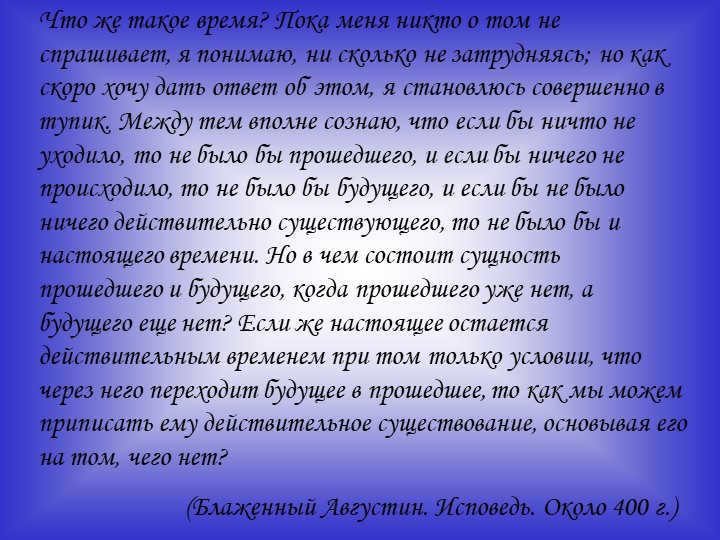
Slide 3: The concept of time is something I can easily understand as long as nobody asks me about it. However, when I try to explain it, I find myself at a loss for words. I do understand that without things passing away, there would be no past. Similarly, without things happening, there would be no future. And if there was nothing that truly existed, there would be no present time. But what is the true nature of the past and the future? The past no longer exists, and the future has not yet come into existence. If the present is only considered valid because it is the moment when the future becomes the past, how can we say that it has a valid existence if it is based on something that doesn’t exist?
(Blessed Augustine. Confessions. ca. 400).
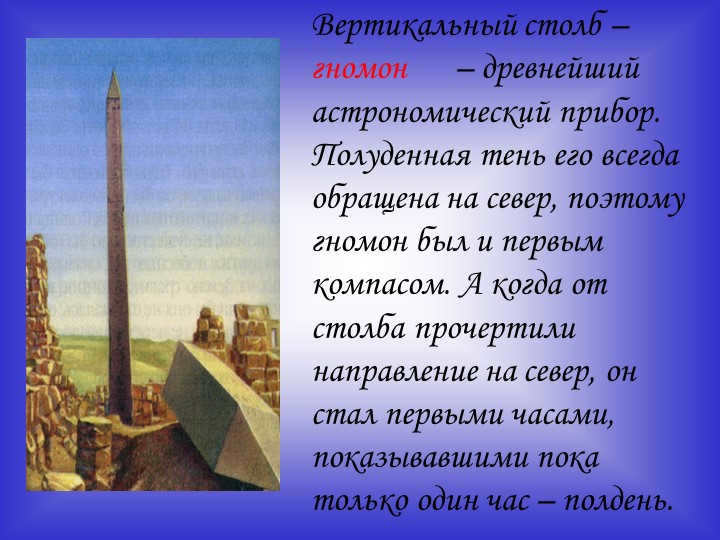
The gnomon, a vertical pole, is the oldest astronomical tool. Its shadow at noon always points north, making it the earliest compass. Additionally, when the direction to the north was marked from the pole, it served as the first clock, indicating only one hour – noon.
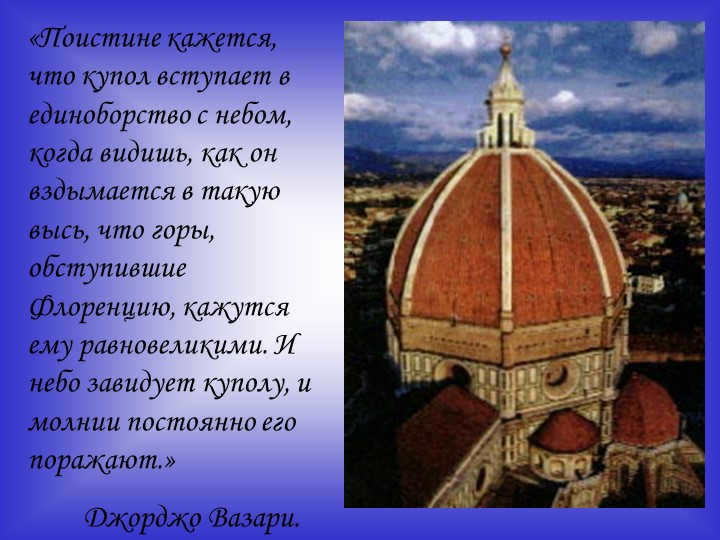
On the fifth slide, it truly appears that the dome engages in a fierce battle with the sky, as it soars to such great heights that the mountains surrounding Florence appear to be on par with it. The sky itself is envious of the dome, and lightning strikes it incessantly. – Giorgio Vasari.
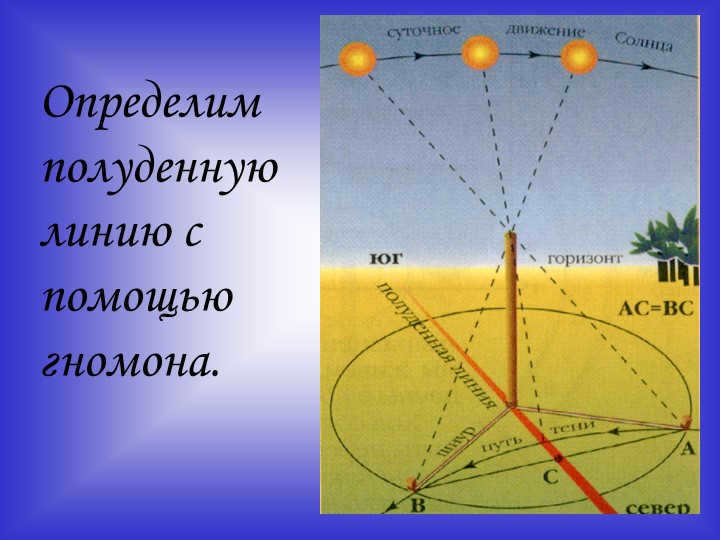
Slide 7: An Earth day refers to the period it takes for the Earth to complete one revolution in space. A solar day, on the other hand, represents the time it takes for the planet to complete one revolution relative to the center of the Sun.
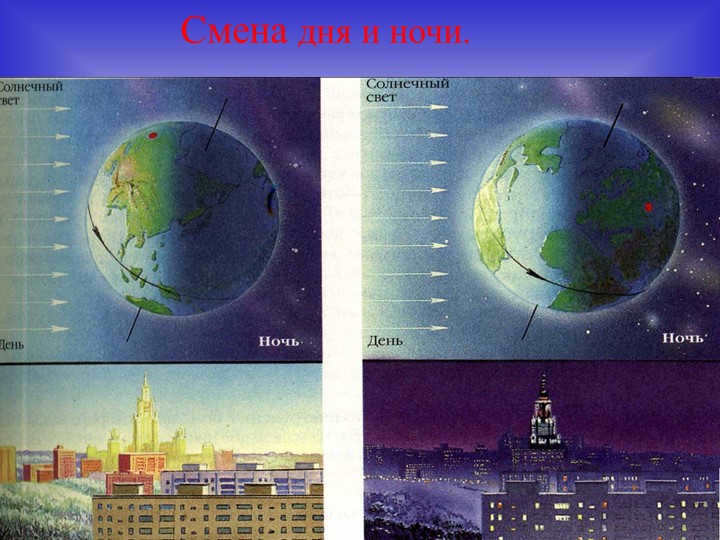
Slide number 9 showcases the Delhi Observatory, home to the largest sundial in the world. Sundials are fascinating instruments that allow us to measure time and visualize its passing by dividing the day into smaller intervals. In 1834, Johann Littrow delved into the wonders of the sky, uncovering its mysteries.
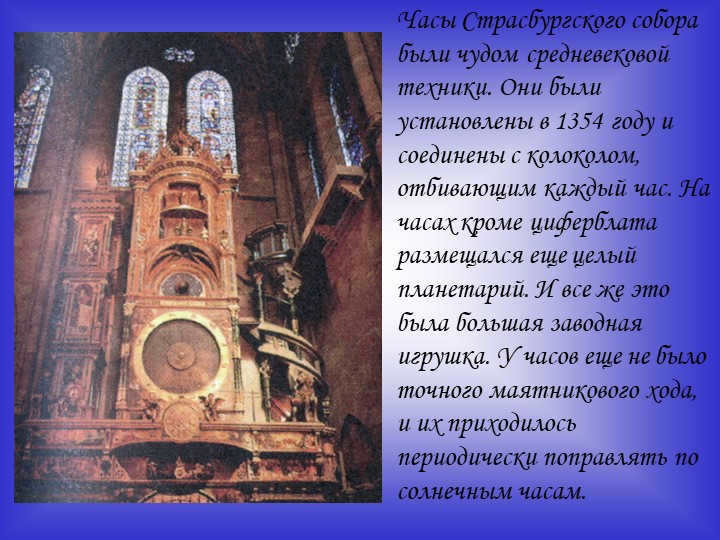
The Strasbourg Cathedral clock, installed in 1354, was an impressive example of medieval engineering. Equipped with a bell that chimed every hour, the clock also featured a planetarium and a dial. However, despite its advanced design, the clock relied on a manual winding mechanism. It lacked an accurate pendulum stroke and had to be periodically adjusted using a sundial.
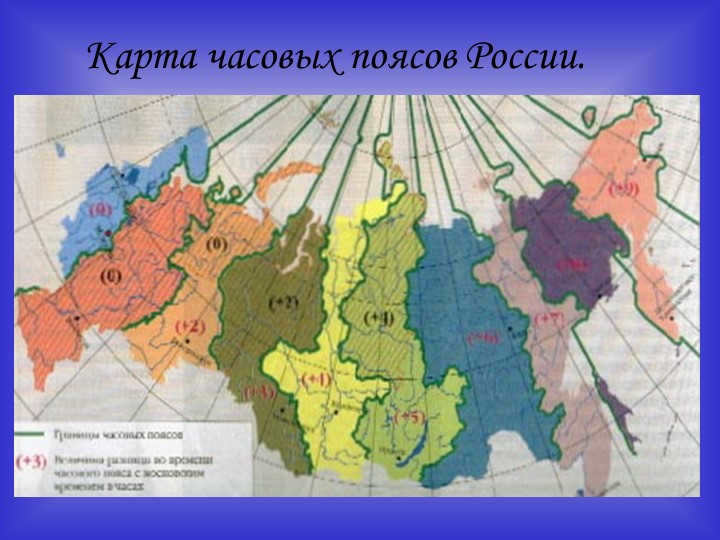
How to calculate local time is a 12-slide presentation. The Earth has a single time called Universal Time (UT). For each location in Russia, which is situated at a specific longitude λ, we can determine the local true solar time Ti, the local mean solar time MT, the zone time Tn, the seasonal winter time Th, the seasonal summer time Tl, and the local sidereal time S. MT is equal to Ti plus η, Th is equal to UT plus n plus 1h, MT is equal to UT plus λ, Tl is equal to UT plus n plus 2h, Tp is equal to UT plus n, and S is equal to s plus MT (approximately). In these equations, η represents the equation of time, n is the time zone number, and s is the sidereal time at Greenwich midnight (a table of sidereal times can be found in astronomical calendars).
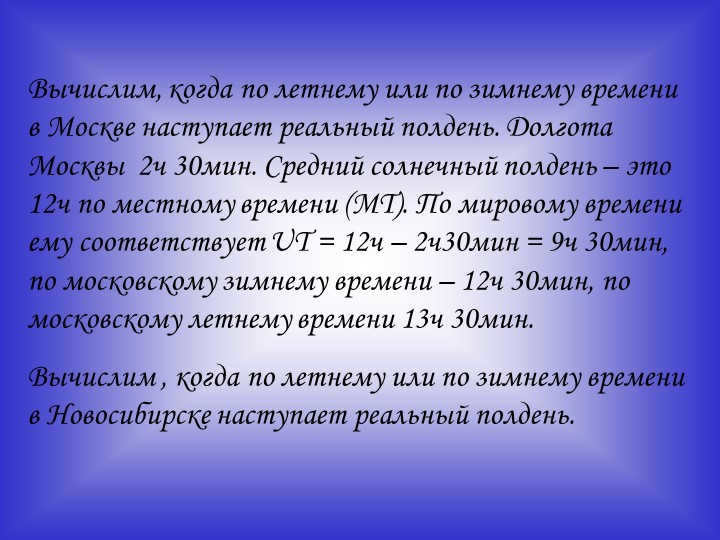
Slide 13 Let's determine the exact time of noon in Moscow based on summer or winter time. Moscow is located at a longitude of 2h 30min. The average solar noon is 12h local time (MT). In terms of world time, this corresponds to UT = 12h – 2h30min = 9h 30min, in Moscow winter time it is 12h 30min, and in Moscow summer time it is 13h 30min.
Let's calculate when the exact time of noon occurs in Novosibirsk based on summer or winter time.
- Certificates to add to your portfolio
- Eternal access for only 99 rubles
- Over 3,800 video lectures available to everyone
Julian days
Astronomers have embraced a specific sequential numbering system for days. Within this system, there is a 28-year cycle where all days and weeks repeat.
John Herschel developed this method of measuring time in 1849. The count of time started at noon on April 1, 4713 BC. Joseph Scaliger proposed the use of this system, and interestingly, he named it Julian after Julius’ father.
Stellar Time
Stellar time can be defined as the hour angle of the point of the vernal equinox, and it is used to count sidereal time.
A sidereal day is the time it takes for two consecutive peaks to occur.
The duration of a sidereal day is the time it takes for the Earth to complete one revolution around its axis, and it is divided into hours, minutes, and seconds. A stellar year has one additional sidereal day compared to the average solar year.
It is important to note that a sidereal day is shorter than an average solar day, with a difference of 3 minutes and 56 seconds. However, the time it takes for the Earth to complete one revolution to the point of the vernal equinox remains constant, resulting in a constant duration for the day.
Solar time
Sidereal time is commonly used in astronomy, but it is not practical for everyday human life. As a result, the concept of solar time was introduced.
This type of time measurement is based on the movement of the Sun’s hour angle.
Calculating solar time involves determining the interval between two consecutive culminations of the Sun. Additionally, whether these culminations are upper or lower plays a significant role in distinguishing between noon and midnight.
True and mean solar time
Solar time can be classified as either true or mean, depending on which Sun it is based on.
True solar time refers to the Earth’s rotation in relation to the actual position of the Sun.
Such days are measured from true midnight, which corresponds to the moment when the Sun reaches its lowest point in the sky.
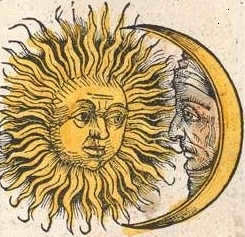
Typically, when we talk about days, we are referring to the astronomical concept of a solar day. In everyday language, a day is commonly understood as a 24-hour period that includes day, evening, night, and morning.
In the field of astronomy, a day is divided into 24 hours, which is equivalent to 1440 minutes or 86400 seconds.
The Concept of a Day in Astronomy
When the orbital and proper rotation directions align, the lengths of stellar (2) and solar (3) days can be compared.
In astronomy, a day is defined as the time between the two upper culminations of the celestial bodies, known as true noon. The duration of a day on a planet is determined solely by its own rotational speed. However, if a distant star is chosen as the celestial body, the length of the day will differ from that of the central luminary in the planetary system. For instance, on Earth, there is a difference between an average solar day (24 hours) and a stellar day (approximately 23 hours 56 minutes and 4 seconds). These two durations are not equal because the Earth’s orbital motion around the Sun causes the Sun to appear displaced against the background of distant stars when observed from the surface of the Earth.
The true solar day refers to the time interval between two consecutive occurrences of the Sun’s center passing through the southern part of the meridian, also known as two true noons. The start of this day is marked by the moment when the Sun’s center crosses the southern part of the meridian. The true time is measured by the hour angle of the Sun’s center, as described in The Equation of Time. It is important to note that true solar days are longer than sidereal days and their duration varies throughout the year. This variation is due to the inclination of the ecliptic to the equator and the uneven movement of the Earth in close proximity to the Sun. [1]
The SI does not include the value of a day in its official definition, but it does allow for its use in calculations. When using the day in calculations, it is commonly accepted that 1 day is equal to exactly 86,400 seconds. However, in the field of astronomy, a day defined in SI seconds is referred to as a Julian day.
According to the SI, a second is defined as 9,192,631,770 periods of radiation that correspond to the transition between the two superfine levels of the ground state of the cesium-133 atom. Based on this precise definition, a day can be strictly defined as 794,243,384,928,000 of these transitions.
In different languages
Most other languages that lack a distinct term for twenty-four hours have the same situation.
Day’s cultural limits
Segmenting the day
The number of divisions of the day varied depending on the level of development of different societies. In the New World, most peoples divided the day into four parts: sunrise, the highest point of the day, sunset, and the middle of the night. However, in Iceland during the 18th century, the day was divided into 10 parts, as described by traveler Gorrebow. The Arabs had a simpler division, distinguishing between sunrise, the sun’s movement, sunset, twilight, night, the rooster’s crow, and dawn. Some uncivilized peoples, such as those in the Society Islands during Cook’s time, had a more precise division of the day into 18 parts, with varying lengths. Morning and evening had the shortest intervals, while midnight and noon had the longest. [3]
24 main parts of the day
In contemporary timekeeping systems, it is widely accepted to divide the day into 24 hours of equal length.
In medieval Europe, the daily time was divided based on church services, which were measured according to the ancient Roman daily calculation. [5] (See Liturgy of the Hours)
In the Novgorod Republic, the daylight hours (day) were also divided into 12 hours, similar to 15th-century Moscow, as evident from the news of Metropolitan Philip I’s death. [6]
Division into twelve primary sections
Division into thirty primary sections
Division into twenty-two primary sections
Variation in the duration of daylight
As a result of the Moon’s gravitational influence, which is demonstrated by the tides, the Earth’s rotation is gradually slowing down. Over the course of a century, the length of the Earth’s day increases by approximately two milliseconds.
The variation in the duration of daylight throughout geological history has been experimentally confirmed through the examination of ring lines found in fossilized corals. Corals produce rings of calcium carbonate on their external skeleton, and the frequency of ring deposition is influenced by both the amount of daylight and seasonal changes. In 1963, the American paleontologist John Wells (1907-1994) uncovered that ring patterns on the epithecium of corals could be utilized to ascertain the number of days in a year during the epoch in which these corals existed. By taking into consideration alterations in the length of the year and extrapolating backwards in time to account for the deceleration of the Earth’s rotation caused by the gravitational pull of the Moon, it is also feasible to determine the duration of a day within a specific geological period. [11] [12] :
| Nowadays | Quaternary | 365 | 24 hours |
| Around 100 million years ago | Jurassic | 380 | 23 hours |
| About 200 million years ago | Perm | 390 | 22.5 hours |
| Approximately 300 million years ago | Carboniferous | 400 | 22 hours |
| Around 400 million years ago | Silurus | 410 | 21.5 hours |
| About 500 million years ago | Cambrian | 425 | 20.5 hours |
The duration of one rotation of a celestial body around its own axis in an inertial reference frame is known as a sidereal day.
When we measure time in relation to astronomical objects, we have two types of twenty-four hour periods: solar and stellar. Both of these are connected to the field of astronomy.
For sidereal days specifically, they last for 23 hours, 56 minutes, and 4 seconds. This is the time it takes for the Earth to complete one full rotation around its axis.
A solar day, on the other hand, is exactly 24 hours. This is the duration it takes for the Sun to traverse the entire sky.
"Civil time refers to a timekeeping system that is based on the average solar day, with the start of each day occurring at local average midnight.
Until 1925, the start of an average day was determined by the moment when the average Sun reached its highest point in the sky. This time, known as average noon, was used by astronomers to avoid splitting the night into two different dates. This type of day was referred to as an astronomical day."
——————————–
Perhaps that is the intended meaning? However, it appears that lawyers are nearly a century behind. )
Throughout the course of human history, time has played a significant role. In astronomy, as in any other field, time serves a vital and fascinating function. It represents the duration of any given action and serves as a measure of life itself. Just imagine, if time did not exist, how would we define everything around us.

Julian days
Astronomers have embraced a unique system of numbering days, known as Julian days. This system consists of a 28-year cycle, where all days and weeks repeat.
John Herschel developed this method of measurement in 1849, and it was proposed for use by Joseph Scaliger. The counting of time in this system starts at noon on April 1, 4713 BC. Interestingly, Joseph Scaliger named it Julian in honor of Julius’ father.

Astronomical Definition of Universal Time
A sidereal day is the time it takes for the Earth to rotate exactly once on its axis, measured with respect to the distant stars. In astronomy, sidereal time is determined by the hour angle of the vernal equinox.
Stellar days are used to measure the Earth’s rotation period. They are divided into hours, minutes, and seconds, and are slightly shorter than solar days. In fact, one year consists of one additional stellar day compared to the average solar year, resulting in a difference of 3 minutes and 56 seconds.
Additionally, the time it takes for the Earth to complete one revolution around the vernal equinox point remains constant. As a result, the duration of a day remains unchanged.
Solar time in the field of astronomy
In the field of astronomy, the use of sidereal time is convenient, but it is not applicable to everyday human life. As a result, the concept of solar time was introduced.
This particular type of time is determined by the variation in the hour angle of the Sun.
This method of time calculation is based on the time interval between two consecutive instances of the Sun reaching its highest point in the sky. It is important to note whether these instances are upper culminations or lower culminations, as this helps differentiate between noon and midnight.
Solar time can be classified as both true and average, as it is influenced by the specific Sun it is based on.
The true solar day measures the Earth’s rotation in relation to the Sun.
This day officially starts at true midnight, which is defined as the moment when the Sun reaches its lowest point in the sky.

The motion of the Sun is not uniform. Consequently, the duration of a solar day on December 22 is longer than on September 23 by approximately one minute. However, this level of inaccuracy proves problematic for precise calculations.
In our daily lives, a day consists of 24 hours. Typically, all measurements are conducted in seconds. Furthermore, individuals distinguish between morning, afternoon, evening, and night when determining the time. This differentiation primarily depends on the Sun’s location relative to a specific meridian.
Nonetheless, the mean solar day is employed for accurate time determination.
It represents the time interval between two successive culminations of the mean equatorial Sun on the same meridian. It is more accurate to state that the mean solar day corresponds to the average of the true solar day.
The Sun’s movement along the ecliptic is characterized by its average speed. This movement converges on January 3 and July 4.
Similarly, the equatorial movement is also uniform, but it aligns with the ecliptic Sun specifically at the vernal equinox. The average equatorial sun remains constant and uniform in relation to true solar time.

Universal Time
Primarily used in astronomy, universal time is a concept that has its origins in geography.
As we learn in school, the Earth is divided into meridians, with a total of 24 meridians. These meridians are spaced 15 degrees of longitude apart.
The main meridian, also known as the world meridian, is the initial meridian with zero longitude.
Meridians run from west to east.
Adjacent time zones differ by one hour. To determine the time in a specific zone, the zone number is needed.

Indeed, zone time refers to the time of a specific time zone. It is widely acknowledged that a day is composed of 24 hours and commences at midnight.
Maternity time
For instance, Russia is divided into 9 time zones. In 1930, the notion of decree time was introduced, which involves adding one hour to the local time.

Moscow time is another term for universal time in astronomy.
This description of time implies the utilization of the time from the adjacent zone. In simpler terms, Moscow time is the zone time plus one hour.
According to the recent ideas, it is referred to as local time.
Ephemeris time
Ephemeris time is a time scale that defines seconds. The calculation of this time scale is independent of the Earth’s rotation rate. It serves as the fundamental unit of time. This concept was introduced in 1952 by J. M. Clemens.
Ephemeris time is constant and is used for the convenience of calculations. It remains unchanged and provides a reliable basis for various calculations.
Time, as we can observe, represents the duration of something. It is considered to be the most unique and valuable measure defined by humans. Furthermore, numerous methods have been devised to accurately calculate it.

Without a doubt, time holds great significance for humanity. It serves as a fundamental aspect of our existence.
The passage of time will unveil the mysteries of the future.
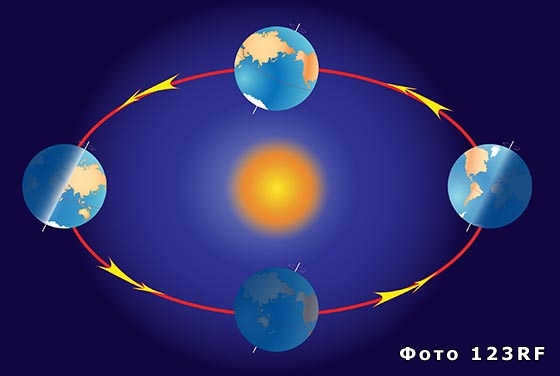
When people realized that measuring time could be useful, they began to take an active interest in it. The main reason was the need to accurately predict the change of seasons, which allowed for planning agricultural work in advance. This led to the development of concepts such as year, month, and day, which are now deeply ingrained in the culture of modern nations and individuals.
It was during the Middle Ages that extensive studies of the starry sky helped uncover the true nature of astronomical phenomena. This led to the formation of different interpretations of basic time terms within scientific knowledge, although not everyone is aware of them.
What is the definition of a year?
A tropical year refers to the period of time it takes for the Sun to return to its original position on the celestial sphere, as observed from Earth’s surface. This duration is approximately 365 days, 5 hours, 48 minutes, and 45.19 seconds, although it may vary slightly from year to year.
On the other hand, a sidereal year is the time it takes for the Earth to complete a full revolution around the Sun and return to its starting point. This is measured relative to the stars, which have a very slow movement on the celestial sphere. The duration of a sidereal year is about 365 days, 6 hours, 9 minutes, and 8.97 seconds.
Lastly, an anomalistic year refers to the period it takes for our planet to return to a specific point in its own orbit, known as pericenter. The duration of an anomalistic year is approximately 365 days, 6 hours, 13 minutes, and 52.6 seconds.
What constitutes a month?
The idea of a month is commonly linked to the modern calendar. However, in historical context, the 30-day cycle is connected to the lunar calendar, specifically the 29-day span of complete phase changes of Earth’s only natural satellite. This type of month is known as a synodic month and lasts for 29 days, 12 hours, 44 minutes, and 2.8 seconds. Similarly to the lunar year, a month can also be classified as tropical, sideric, or anomalistic.
Many individuals have assigned names to each month based on their characteristics, but it is challenging to identify such patterns in the contemporary Gregorian calendar. This is because the month names in this system are derived from the Latin Julian calendar, and when translated into Russian, they possess a clear meaning: September is the seventh, October is the eighth, August is named after Octavian Augustus, July is named after Julius Caesar, and so on.

